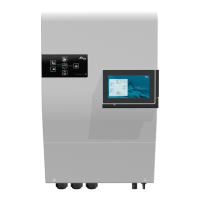
Do you have a question about the Studer NEXT3 and is the answer not in the manual?
| Brand | Studer |
|---|---|
| Model | NEXT3 |
| Category | Industrial Equipment |
| Language | English |
Explains symbols and conventions used for safety and information.
Describes the manual's scope, structure, and related documents.
Crucial safety guidelines for installation, operation, and maintenance.
Details product quality, warranty terms, and exclusions.
Lists conditions that void the product warranty.
Specifies limitations of the manufacturer's liability.
Provides guidelines for safely handling and moving the device.
Specifies the recommended environmental conditions for storage.
Shows dimensions for wall-mounted installations.
Displays dimensions for 19'' rack-mounted units.
Provides physical dimensions for the nx-interface.
Details the procedures for unpacking and mounting the unit.
Specifies ideal locations and criteria for device mounting.
Step-by-step instructions for unpacking and mounting the unit.
Provides a general overview of the wiring process.
Illustrates the overall system block diagram.
Offers crucial general recommendations for wiring.
Details the overview of all device connections and terminals.
Specifies recommended torque values for various connections.
Summarizes maximum cable cross-sections for different connections.
Guides on connecting the battery to the system.
Explains how to correctly dimension the battery bank.
Details various options for battery bank wiring configurations.
Covers cable sizing and protective devices for battery connections.
Provides step-by-step instructions for connecting the battery.
Details the battery connection process on the next3 unit side.
Details the battery connection process on the battery side.
Explains the procedures for earthing the battery system.
Crucial safety precautions for handling and using batteries.
Details how to connect the battery temperature sensor.
Covers CAN bus connection for batteries with a communicating BMS.
Guides on connecting the AC power sources and loads.
Guides on selecting and sizing AC protective devices.
Explains the AC neutral and earthing system requirements.
Describes neutral continuity in stationary installations.
Covers AC connections for mobile or plug-connected installations.
Details connection specifics for models without transfer.
Guides on connecting the solar PV generator.
Explains how to dimension PV strings for optimal performance.
Details the connection points for PV strings.
Covers the requirements for earthing the PV system.
Discusses PV cables and their appropriate cross-sections.
Details the necessary protection devices for PV connections.
Addresses measures for protecting the system against lightning strikes.
Guides on connecting communication cables within the system.
Explains how to connect the nx-interface to the Studer nx-bus.
Details how to establish an internet connection via the nx-interface.
Covers wiring for auxiliary inputs and outputs.
Describes the wiring and function of auxiliary contacts.
Explains the setup and usage of command input terminals.
Notes the future availability of RS485i communication features.
Details how to configure systems with multiple next3 units.
Covers extending an existing installation with additional units.
Emphasizes the mandatory initial configuration process.
Explains the functions controlled by the front panel button.
Details the meaning and states of the front panel LEDs.
Describes the functionality and control of the buzzer indicator.
Explains basic navigation, icons, and usage of the nx-interface.
Provides a map illustrating the nx-interface screen hierarchy and navigation.
Describes the nx-interface's built-in documentation feature.
Details user accessibility levels, codes, and customization options.
Explains how to set up and use custom access codes for security.
How to view and interpret the energy system's status on the nx-interface.
Overview of the simple dashboard for quick system status.
Detailed view of system components and their status in synoptic mode.
Describes the simple chart display for energy data visualization.
Explains how to access and interpret system messages and events.
Outlines the various functionalities offered by the nx-interface.
Details the remote control features and settings of the nx-interface.
Procedure for setting the device's date and time.
Instructions for managing USB memory sticks with the nx-interface.
Procedures for updating the system software via USB or internet.
Guides through the process of configuring the energy system installation.
Step-by-step wizard for initial system setup and configuration.
Information on backing up and restoring system configurations (feature not yet available).
Covers setting up and utilizing system monitoring and data logging features.
Details local data logging methods and retrieval via USB.
Instructions for setting up remote monitoring via the Studer web portal.
Key concepts and principles for understanding the next3 system.
Explains the system's energy management strategy and logic.
Describes common system configurations and their default behaviors.
Step-by-step guide for initial system setup using the wizard.
Provides general information about the AC source connection.
Displays detailed information about the AC source status and parameters.
Configures AC source settings specifically for grid connection.
Configures AC source settings for genset connection.
General overview of the solar PV system integration and operation.
Displays detailed information about the solar PV system's performance.
Configuration settings for optimizing the solar PV system.
General information about battery types and charging processes.
Displays detailed battery status and operational information.
Configuration settings for the battery system.
Provides further details and explanations on battery functions.
Explains the different stages of the battery charging cycle.
Details temperature compensation for battery charging adjustments.
General information about connecting and managing AC loads.
Displays detailed information about the connected AC loads.
Configuration settings for managing AC loads and inverter function.
General information about the AC-Flex connection's versatility.
Configuration and information for using AC-Flex as a source.
Displays information when AC-Flex is configured as a load.
Configuration settings for using AC-Flex as a load.
Overview of the device's I/O interfaces and general points.
Displays information regarding the device's status and auxiliaries.
Configuration settings for the auxiliary contacts.
Configuration settings for command input functions.
Notes the future availability of RS485i communication settings.
Configuration settings for the earthing relay.
Sets the priority for selecting between multiple AC sources.